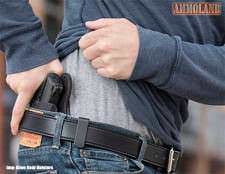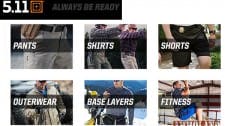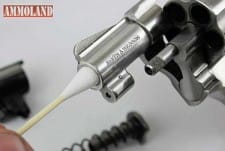12 Steps For Concealed Carry Success
by Ben Findley*

USA – -(Ammoland.com)- “These are the times that try men’s souls” was written by Thomas Paine, patriot and United States Founding Father, in his book The American Crisis in 1776.
Now some 240 years later, being faced with menacing terrorist activities here at home and abroad, we can certainly identify with his words. We are even more aware now of the necessity for being prepared just in case to defend our way of life and our very lives.
There are things we can do now to be prepared for our own personal protection when we carry concealed.
What follows are my 12 key guidelines and prerequisites to help you to achieve concealed carry success.
Concealed Carry Success Step 1: Accept Responsibility and Have Proper Mindset.
As armed and legally-licensed concealed carriers, we have the ability to instantly defend ourselves and others in deadly force encounters and this has far-reaching affects. With this ability, comes tremendous responsibility to use our handguns appropriately for lawful self-defense, to employ correct fundamentals of shooting, and to follow the handgun safety rules.
Carrying a handgun means you have great responsibility both before and after a self-defense shooting. You must have a disciplined and proper concealed carry (CC) mindset.
If possible to do so safely, you should retreat and avoid an encounter. This does not mean you are weak, afraid, or do not have the skills for defensive action. When engaging someone in a confrontation with a handgun, it can get out of hand quickly.
So, if appropriate for your situation, emphasize overall safety and go out of your way to avoid conflict and confrontations. Any time you introduce a handgun into any situation, you escalate it and blow it out of proportion… just because there is a gun involved.
Also, after the use of a gun, in most states you must show that you used deadly force appropriately and justify your actions. This can be difficult to do, depending on the variables in the situation. Are you innocent until proven guilty or do you have the burden of proof to justify your use of deadly force?
One must be disciplined with a controlled and mellow, easy-going attitude and accept responsibility for all of one’s actions. There can be many complexities, time, and costs involved with your use of deadly force, even in a righteous shoot. I believe John Farnham was the first to say “The best way to ‘win’ a gunfight is to avoid it all together.”
Recognize that a gun is only a tool and the mind is the true weapon.
Concealed Carry Success Step 2: Be Prepared with Comprehensive and Thorough Handgun Training

It is important that your training and skills in shooting your handgun be current and include the latest techniques, basics, and strategies. The training should include not just the fundamentals of grip, stance, sight alignment, sight picture, trigger control, and breath control, but also key topics like reloading techniques, shooting while moving, drawing, multiple targets, one-handed shooting, and support-hand shooting, etc. Continued education and training in and beyond the basic fundamentals are important. If the training you receive and the drills and repetitions you do in your practice are incorrect and outdated, you will not be properly prepared and will train poor technique or incorrect fundamentals into your muscle memory.
If you take a short handgun course or try to get by with just an overview of topics with minimal training, you are cheating yourself and it may jeopardize your life. Do not settle for training that does not include hands-on, live-fire training. If possible, get training from a certified, currently-trained and experienced professional, rather than Rifleman Bill or Uncle Jim who was in the military 20 years ago. There are differences between long gun rifle and shotgun training and handgun pistols and revolvers. Do not believe you are prepared just because ten years ago or so you received a solid basics course.
Techniques and methods improve and change, so you can learn something by attending a new refresher course.
Concealed Carry Success Step 3: Understand Handgun and Deadly Force Laws in Your State and Jurisdiction
You should know the current handgun laws and requirements for your state and jurisdiction, so learn them from a legal professional in your area. This includes such laws as your Castle Doctrine, Stand Your Ground Law, use of deadly force, self-defense, brandishing, improper exhibition, warning shots, CC reciprocity, off-limits carry, home protection, etc. Learn when you can shoot and when you cannot shoot, according to your state’s laws and your jurisdiction. You also need to know if you are required to show your CC license/permit when stopped routinely by a police officer, what are the disparate force factors, and how to communicate with the police if there is a shooting, and what to do after a shooting, etc.
Concealed Carry Success Step 4: Carry Regularly
You should carry ALL the time, if legally licensed to do so. There are several excuses often given for not carrying, so put them aside and always carry.
Do not use the potential for legal problems as an excuse to not carry.
Some justify to themselves for not carrying by saying that the threat level is not that high. They carry only when they feel very endangered. Reality today is that any place and any situation has the potential to escalate and be dangerous, including even [or especially] gun-free zones like schools, malls, churches, etc.
Some justify to themselves not carrying because it is uncomfortable. The holster is rubbing, the gun does not fit right in the holster, it won’t conceal properly under my shirt or with shorts, etc. So fix it.
If the gun is too heavy, too long, too wide, has too much recoil, does not fit right, or if your holster, belt or carry method is not optimal, then change them. Any gun with you is better than the gun left in the safe at home. Find the best gun, holster, belt, carry rig combination that works best for you and carry it always. Become comfortable carrying with a round in the chamber and the safety engaged. B disciplined with the proper training to not put your finger on the trigger until you have your eyes and sights on the target and you are ready to shoot.
You will never know when that fateful encounter might occur. Be prepared just in case.
Concealed Carry Success Step 5: Do Not Constantly Check Your Carry Gun
Most people do not even notice that you are carrying, so do not be so self-conscious and feel that everyone is staring at your gun. Usually only those that carry themselves or law enforcement personnel will really notice. You draw attention to yourself and look suspicious when you constantly tug and adjust your shirt. There is no need to constantly check, adjust, and think about how your gun is riding, if your shirt is properly covering it, if your pants are too tight to reveal the gun’s outline, etc. You do not have to repeatedly touch your gun through your shirt to see if it is properly positioned.
So, break that habit because you can actually draw more attention to yourself and your gun.
Concealed Carry Success Step 6: Practice with Your Carry Gun and Self-Defense Ammo
Certainly, it is important to train with the gun and ammo you carry. Recognize that the techniques and fundamentals you routinely perform in training when you practice become engrained in your muscle memory and become automatic responses in stressful encounters. Of course, they do influence your performance in actual self-defense and deadly force encounters.

Get very familiar and comfortable with your gun, holster, ammo, mag pouch, and other accessories, so you can naturally use and handle them easily and effectively in emergency encounters. They should be second nature to you. For example, most carry hollow point rounds, but mostly train with least expensive full metal jacket ammo.
However, you should also train regularly with your hollow point rounds to get familiar with how your gun cycles and handles it. Do not let the higher cost of the self-defense hollow point ammo deter you from practicing with it. What price do you place on your life?
The gun you carry is probably going to be a compromise and blend of various features. Guns with longer barrels, heavier weight, and bigger dimensions and calibers which are generally considered to be more capable may also be more difficult to conceal and may require more practice for optimal accuracy.
However, you also need to understand that concealment is usually more a matter of holster design and cover garments than gun size. It is your responsibility to weigh the several personal considerations and decide and select the “best” gun and ammo for yourself.
I believe it is crucial to shoot your gun before you buy it and use it to defend your life.
Concealed Carry Success Step 7: Select a Proper Holster
A custom made, quality holster from a reputable manufacturer is designed specifically for your carry gun, if you carry with a holster. Sure, you can keep your gun in a nylon holster when it’s in the range bag, but use a quality, custom-fit holster for your carry gun. This also applies to carry by fanny pack, day planner, etc.
A holster or carry device made for your gun model will usually allow you to draw and secure your gun better, as well as help to make it more concealable and accessible. It will fit your gun better. A customized holster for your specific gun model will completely cover and protect the trigger from contact with outside objects, including your trigger finger. A properly-designed holster made specifically for your gun will retain the gun until you intentionally draw it.
Inside-the-waistband (IWB) holsters are usually more concealable, but may be less comfortable. They may also require a bigger trouser and belt size to compensate for the added bulk. An outside-the-waistband (OWB) holster is usually more comfortable, but also usually more difficult to conceal.
You can make your carry gun concealable, but sometimes at the cost of a much slower access and draw. Or you can have a faster access and draw, but with less concealability, giving up a major tactical advantage.
This is your personal decision.
Concealed Carry Success Step 8: Select a Proper Gun Belt

A quality gun belt is extremely important to support your handgun… some believe even more so than a holster. In any event for most folks, a gun belt is a must-have accessory for your handgun rig. You need the support for your gun and accessibility that you can count on. A rigid, high-quality, full-grain, bull-hide leather gun belt will help minimize movement of your gun, be strong and resilient for long-lasting durability, help distribute weight, and add to comfort. A leather belt that has been reinforced with an inner layer of Kydex will be rigid and help it from deforming, rolling up and sagging. Price is usually an indicator of quality, so spend the money to get a good gun belt, rather than the low-priced discount store flimsy belt.
Concealed Carry Success Step 9: Select Proper Carry Clothing

In some areas, you may carry the same way all year long, while in other locations, you may wear shorts and T-shirts in the summer and heavy coats and gloves in the winter. The climate, your job, lifestyle, daily activities and where you live have a significant affect on your Concealed Carry Clothing. These differences can be frustrating and challenging, but you must adapt. A plain white dress shirt, for example, is usually plenty of concealment if you’ve got an IWB holster. A loose, untucked casual shirt, like a guayabera, Hawaiian or camp shirt can easily hide the grip of a handgun from the casual observer. A sweatshirt or hoodie adds bulk around the waist that probably can hide most large handguns. It just depends on your gun, its size and dimensions, and your body build.
I find as a horizontally-challenged geezer in warm Florida weather that wearing loose and baggy clothing and oversized, untucked casual shirts make CC easier, but not so stylish. I live with it.
On occasion, I switch from OWB carry to IWB carry and it seems to conceal some of my smaller guns better. Another option is to consider carrying one of the smaller firearms, be it one of the new .380s or 9mms. There are many lightweight, ergonomically-rounded, reduced-snag polymer-framed pistols and revolvers made especially for carry. Whether you change your method of carry for one day or the entire season, remember the importance of being familiar with your carry method. Some CC methods require you to access and get past clothing used as cover, which makes drawing more difficult and time consuming.
Practice is key for you to be able to deal with your clothing as cover, draw properly, etc.
Concealed Carry Success Step 10: Focus on Situational Awareness

Situational awareness (SA) is of critical importance for everyone at all times. We should be cautious, practice observation, scan and assess our particular environment, and know the variables at play in each situation we encounter, even though it is difficult to do so sometimes.
SA is simply knowing what’s going on around you and knowing your surroundings. It sounds easy in principle, but in reality requires much practice and keen observation skills and focus. This is challenging in a stressful encounter or even in a non-threatening environment. We tend to “behave in a way that makes sense to ourselves” and unwittingly neglect certain things. Our reality is based on our limited set of experiences and relative knowledge. It makes “sense” to us because of particular unique experiences, controllable and uncontrollable factors — some of which we may not be aware. Maybe it is because we “don’t know what we don’t know.”
Research shows that when we get nervous or stressed, our attention and focus narrows, causing us to concentrate on just a few things at a time. A narrow focus can therefore cause us to miss important threats and details in our environment. SA is an important skill to learn which takes focus and concentration with a big-picture perspective.
In a dangerous situation, being aware of a threat even seconds before everyone else can keep you and your loved ones safe.
Concealed Carry Success Step 11: Know Your Handgun and Maintain It Properly

You should develop skills with your particular carry gun so you can respond without thinking about where your external safety, magazine release, slide-lock lever and controls are located on your gun. Some say it takes about 3,000 to 5,000 repetitions of the same action or behavior to develop and instill an automatic muscle-memory response, as a subconscious reaction to an external stimuli. So you have to practice clearing that malfunction, for example, over and over again with the gun you carry.
If a specific shooting skill or technique is performed incorrectly and continually repeated, then unfortunately the muscle memories created for how you complete the task will also be flawed. So, you will not perform it correctly when you must perform it (automatically) in a deadly-force encounter.
When beginning to learn a new shooting skill or technique, it is best to go slow and pay close attention to what and how you are performing it. This ensures the actions being repeated later are correct as opposed to incorrect.
Know how to operate and use your handgun without taking time to think about it. Develop the muscle memory. Sadly, some law enforcement officers have been killed in the line of duty because of their lack of familiarity with their handguns and incorrect training procedures or lack of practice. Take time to regularly practice with your CC gun and use your self-defense ammo to practice with occasionally.
It is necessary to regularly maintain and clean your CC gun. Every time I shoot my gun, even if only 50 rounds, I clean it. Some say that is not necessary, but I want to have the peace of mind and security knowing that my gun’s reliability probability will be increased because of the ten minutes I took to clean it. I do not want to take even a 1% chance of death because I didn’t devote just a few minutes to clean and maintain my gun.
I believe you should inspect, function check, clean and maintain your concealed carry gun at least monthly.
Concealed Carry Success Step 12: Practice, Practice, Practice

Without a doubt, training in the fundamentals of shooting your carry gun and the key safety rules are mandatory for effectiveness. Start your CC training by analyzing your present skills and where you need improvement. Maybe you need to focus on trigger control and speed. Or maybe shooting one-handed or while moving. It is imperative to build positive and useful training and practice habits early.
Shooters should review their training process and topics on an annual basis and constantly, then design your practice plan with specific drills to help improve certain identified skills or areas needing improvement.
There is always something to learn or improve upon. Shooting fundamentals and skills are perishable, and they deteriorate if not practiced. You must practice on a regular basis. Every year I try to complete at least one course for improvement. Recognize that while practice is critical, so is how you practice. Do not just shoot holes in paper, but have a planned course of fire and specific drills to focus on key fundamentals and areas where you need improvement. Snap caps and dry firing can be helpful. Snap Caps ( http://goo.gl/PM040U ) have a spring-damped false primer or one of plastic that cushions and protects the firing pin for many repeated strikes and protects your gun’s components. Dry firing is practicing at home with snap caps and an unloaded gun. Understand that while dry-fire practice drills with snap caps are useful, there is no substitute for live fire practice. Try to plan a monthly range shooting practice session, but go at least every 7 to 8 weeks as a minimum.
You can practice dry firing as a supplement in your home once a week. Be prepared and practice. It just might save your life.
Continued Success and Be Safe!

About the Author Col. Ben Findley *
Col. Ben Findley is retired with 30 years service in the U.S. Air Force, with joint services Special Ops duty and training, and is Air Force qualified as “Expert” in small arms. Ben is an experienced NRA-certified pistol instructor, NRA range safety officer and Florida concealed carry license instructor. Ben recently wrote the book “Concealed Carry and Handgun Essentials for Personal Protection” with 57 comprehensive chapters about concealed carry and handgun principles, techniques and tips for both experienced and new shooters. His reference book is endorsed by several organizations and is available on his website FloridaHandgunsTraining.com. Contact him at ColBFF@gmail.com.
Lead Photo: Alien Gear
* This personal opinion article is meant for general information & educational purposes only and the author strongly recommends that you establish your own criteria based on your personal needs, goals, purpose, and priorities. It should not be relied upon as accurate for all shooters & the author assumes no responsibility for anyone’s use of the information and shall not be liable for any improper or incorrect use of the information or any damages or injuries incurred whatsoever.
© 2015 Col Benjamin Findley. All Rights Reserved. This article may not be reprinted or reproduced in whole or in part by mechanical means, photocopying, electronic reproduction, scanning, or any other means without prior written permission. For copyright information, contact Col Ben Findley at ColBFF@gmail.com.
http://www.ammoland.com/2016/01/12-steps-for-concealed-carry-success/#axzz3xSHHUQ71

DOWNLOAD $12,234 within 2 months CASINO Software?
ReplyDeleteLet me get it straight.
I dont care about sports. Shame on me but I dont even know the soccer rules. Never cared less.
I tried EVERYTHING from FOREX & stocks to internet systems and affiliate networks.. I even made some money but then blew it all when the stock market went south.
I think I finally found it. Grab It Now!!
These steps are very well. for helping us to achieve concealed carry success.
ReplyDelete